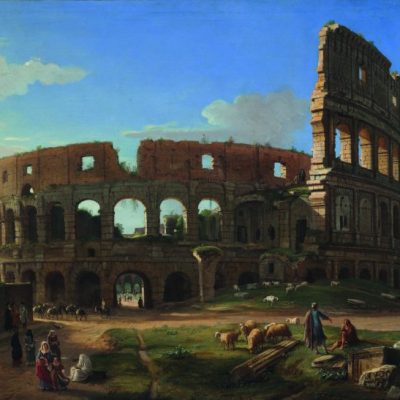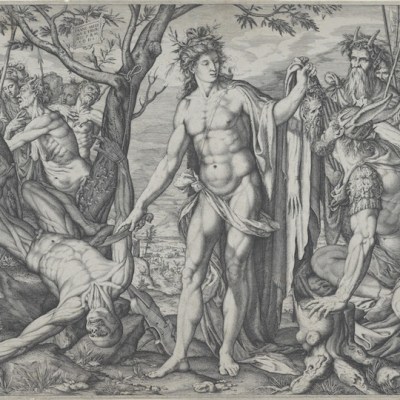For centuries, grasping the totality of Rome’s topography has been an alluring dream. In the third century AD, a 60 ft by 45 ft marble map of Rome was mounted in the Temple of Peace, at a scale of about 1:240, covering 150 marble slabs. In the 16th century, Pirro Ligorio produced his extraordinary reimagining of the city of Rome from a birds-eye perspective. By the time of Piranesi, the extant fragments of the great marble map could be seen as reflecting the contemporary awareness of the topography, only partially known, of the ancient city. Piranesi and Robert Adam sought to recover the ancient city, often using principles of symmetry and geometric regularity to complete buildings known only in ruins.
Giambattista Nolli’s 18th-century map of the Rome of his day set new standards for cartographic accuracy. As the 19th century progressed, knowledge resulting from archaeological excavation would be combined with the contemporary city in Rodolfo Lanciani’s brilliant Forma Urbis Romae (1893–1901), which draws the ancient remains in red ink under the modern city.
Many early 19th-century maps of the unexcavated Forum misidentified almost every building. Huge strides have been made, but there remain intense and mystifyingly angry debates over key buildings. The observer might be tempted to think of what Mr Brooke said to Casaubon and Dorothea in Middlemarch, ‘about topography, ruins, temples – I thought I had a clue, but I saw it would carry me too far, and nothing might come of it. You may go any length in that sort of thing, and nothing may come of it, you know.’
 There were two great adventures in topography in the 20th century: Platner and Ashby’s Topographical Dictionary (1929), and the Lexicon Topographicum Urbis Romae (LTUR; 1993–2000). Both are rooted in a careful analysis of the sources and present the buildings alphabetically; no student of Rome can afford to be without them. Yet the obvious drawback of analysing Rome building by building is that a broader understanding of the regional context is lacking. Moreover, Platner-Ashby is not illustrated, while LTUR illustrates discrete individual buildings, often lifting excavation-report material, and therefore avoiding the perils, but also the benefits of reconstruction.
There were two great adventures in topography in the 20th century: Platner and Ashby’s Topographical Dictionary (1929), and the Lexicon Topographicum Urbis Romae (LTUR; 1993–2000). Both are rooted in a careful analysis of the sources and present the buildings alphabetically; no student of Rome can afford to be without them. Yet the obvious drawback of analysing Rome building by building is that a broader understanding of the regional context is lacking. Moreover, Platner-Ashby is not illustrated, while LTUR illustrates discrete individual buildings, often lifting excavation-report material, and therefore avoiding the perils, but also the benefits of reconstruction.
For many years, starting from a regional perspective, and fully open to an adventurous ‘grammar’ of reconstruction, Andrea Carandini’s team has been labouring to produce a radically different vision of Rome. The most recent emanation of this is the updated English-language translation of the 2012 Italian original. It is both indispensable and infuriating, a triumph and a torment.
Volume One describes the 14 regions of Augustan Rome at the beginning of the first century AD. These are presented diachronically, and include observations on the history of discovery. A student can learn how the city came to be found and described over time. This is a really significant advance in the account of Rome’s topography. The text is accompanied by sections of illustrations, reconstructions, and some of the finds which have usually been repositioned in museums. One way of consuming the feast of information with which we are presented is to read the long essays. The challenge of course is finding the actual buildings in these dense essays. So we need to have Volume Two open at the same time.
The latter consists of, for the most part, the maps and reconstructions of individual buildings in the order of the regions. What is immediately striking, and completely innovative in comparison with previous versions, is the level of confident reconstruction. Buildings are presented as full architectural plans, elevations, or hypothetical wholes. Colours reflect what we know and what we surmise. The ratio between the former and the latter varies dramatically, and in some instances the former is alarmingly little, for instance in the reconstructions of archaic housing in the Forum. The next section contains large-format maps, a ‘new Lanciani’, in which the old city and the modern are integrated. Every location has a number, indexed in a grand concordance, where one can look up individual buildings, and separately in what are called ‘topographical units’.
Rendering of the Campus Martius in The Atlas of Ancient Rome, edited by Andrea Carandini.

The magnitude of the achievement cannot be overestimated. If LTUR was the late 20th century’s greatest contribution to the topography of Rome, the Atlas is the next major step. The quantity of material is extraordinary. Every footnote contains something which is fascinating, or weird, or controversial, from fruit sellers by the Campus Martius to the discovery of a hidden room full of amphorae on the Palatine. One could disappear into the Atlas and never come out again. For the sheer size and the format means that the Atlas is a labyrinth. The back and forth between essay, map, index and illustrations is bewildering, and it is immensely easy to lose one’s place, especially since there is no concordance between topographical units and sites. Moreover, the same monument can be found in several places, unlike the unified treatment we find in LTUR, so it is much harder to grasp the essential information.
In the end, then, the Atlas does not replace LTUR or the beloved Platner-Ashby, and it has already set off as many arguments as it aimed to solve. The team takes a far more positive attitude to the evidence for early Rome, for instance, than most modern scholars. The reconstructions are so beautifully done that it will be tempting for the unwary to believe them. Inevitably this represents a vision of Rome – and, in some ways, for all the technological underpinning, it is an old-fashioned holistic vision, somewhere between Ligorio’s reconstruction and Lanciani’s combination of old and new. The Atlas is destined to be a point of reference, and much of what it does it does extremely well. Its complexity, however, comes close to imitating the complexity of Rome itself. As in the back streets of Rome, beware that you may get lost!
The Atlas of Ancient Rome: Biography and Portraits of the City is edited by Andrea Carandini (Princeton University Press).
From the February 2018 issue of Apollo. Preview and subscribe here



